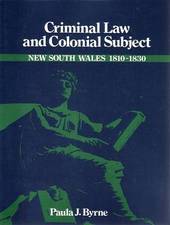
|
Criminal Law and Colonial Subject
Paperback / softback
Main Details
| Title |
Criminal Law and Colonial Subject
|
| Authors and Contributors |
By (author) Paula Jane Byrne
|
| Series | Studies in Australian History |
|---|
| Physical Properties |
| Format:Paperback / softback | | Pages:316 | | Dimensions(mm): Height 246,Width 189 |
|
| Category/Genre | Colonialism and imperialism
National liberation, independence and post-colonialism |
|---|
| ISBN/Barcode |
9780521522946
|
| Classifications | Dewey:345.944 |
|---|
| Audience | | Professional & Vocational | |
|---|
| Illustrations |
31 Tables, unspecified; 16 Line drawings, unspecified
|
|
Publishing Details |
| Publisher |
Cambridge University Press
|
| Imprint |
Cambridge University Press
|
| Publication Date |
18 December 2003 |
| Publication Country |
United Kingdom
|
Description
This book explores the relationship of a colonial people with English law and looks at the way in which the practice of law developed among the ordinary population. Paula Jane Byrne traces the boundaries among property, sexuality and violence, drawing from court records, dispositions and proceedings. She asks: What did ordinary people understand by guilt, suspicion, evidence and the term "offense"? She illuminates the values and beliefs of the emerging colonial consciousness and the complexity of power relations in the colony. The book reconstructs the legal process with great tetail and richness and is able to evoke the everyday lives of people in the colonial NSW.
Reviews'Philip Davis and Joe Byrne inject life into the statistical bare bones of sectoral balance sheets. These stock data give a current picture of the accumulated flows (deficits/surpluses) of bygone years, and of their financing patterns. In turn, knowledge of this changing history, and of the current stock position, gives the authors an excellent platform for discerning likely future financial trends, including a discussion whether bank-based (Continental Europe and Japan) and market-based systems (Anglo-Saxon countries) are likely to converge. Questions about the nature, and relevance, of differences in financial structures are perennial. Those concerned with such issues will find this book a 'must buy'.' Professor Charles Goodhart, LSE and Bank of England
|